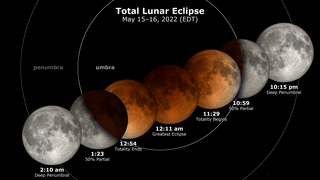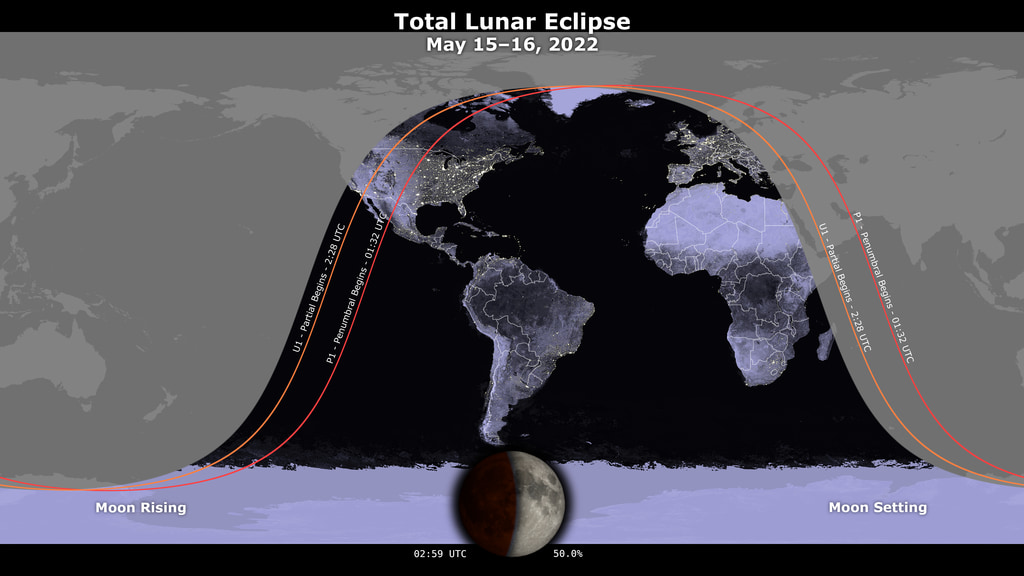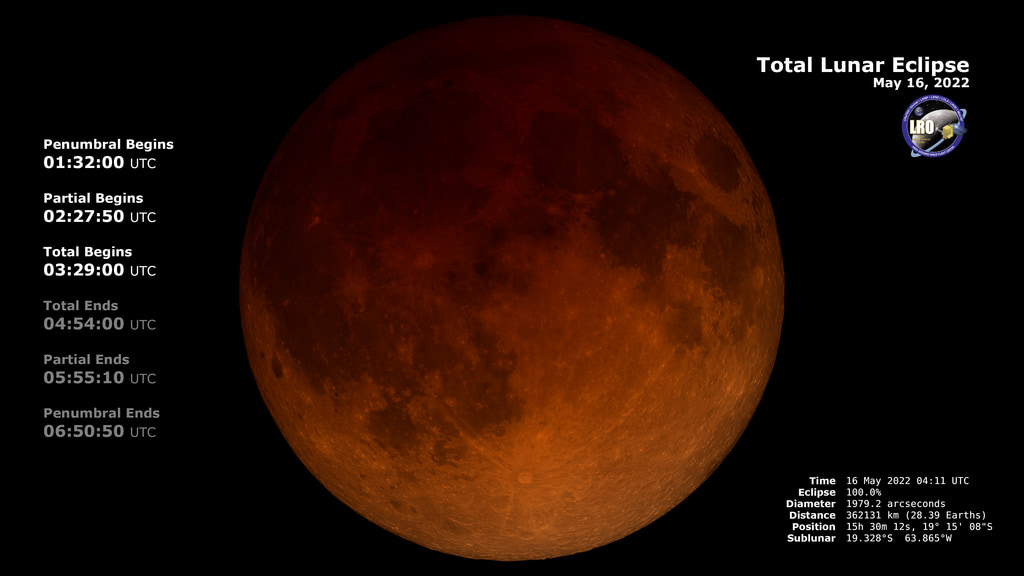NASA Interview Opportunity: Skywatchers’ Delight! Chat with NASA About How YOU Can See Next Weekend’s Total Lunar Eclipse

QUICK LINK TO EDITED, CUT B-ROLL
Quick link to canned interview with NOAH PETRO
Quick link to canned interview with BRETT DENEVI
Canned interview in SPANISH with FRANCISCO ANDOLZ
NEW!!: NASA Extends Exploration for 8 Planetary Science Missions including the Lunar Reconnaissance Orbiter.
As summer approaches and the weather warms up, our nearest celestial neighbor has a special treat for skywatchers – a total lunar eclipse visible across North and South America the evening of Sunday, May 15. For 84 minutes, the Moon will cross through Earth’s shadow, making the full Moon appear a coppery red as it reflects back all of Earth’s sunrises and sunsets. In preparation for this cosmic event, NASA experts are available to share details on how to view the eclipse plus highlights of lunar science as NASA prepares to send the next generation of explorers to the Moon with the Artemis program.
Live interviews in English or Spanish will be offered in 9-minute slots on Friday, May 13, 2022, from 6:00 a.m. to 1:00 p.m. Eastern Time.
Click here to request an interview: https://forms.gle/1NkyTGQCXvyRNKpF7
Requests sent via the above form will have scheduling priority. We cannot guarantee a slot if the request is emailed.
NEW! SATELLITE COORDINATES ARE AVAILABLE
HD Satellite Coordinates for G17-K18/Upper:
Galaxy 17 Ku-band Xp 18 Slot Upper| 91.0 ° W Longitude | DL 12069.00 MHz | Vertical Polarity | QPSK/DVB-S | FEC 3/4 | SR 13.235 Mbps | DR 18.2954 MHz | HD 720p | Format MPEG2 | Chroma Level 4:2:0 | Audio Embedded
Participating Experts:
Brett Denevi / Lunar Scientist, JHU Applied Physics Laboratory
Jim Garvin / Chief Scientist, NASA Goddard
Andrea Jones / NASA Science Communicator
Noah Petro / LRO Project Scientist
Michelle Thaller / NASA Scientist
Molly Wasser / NASA Science Communicator
Ryan Watkins / NASA Program Scientist
Francisco Andolz / LRO Mission Director
Bea Gallardo-Lacourt / NASA Space Scientist
Spanish speaking talent
Do you have feedback for the Live Shot Program? We would love to hear from you HERE!
Suggested Anchor Intro:
So many of us look up at the Moon, and this Sunday, the Moon is giving us a special show. A total lunar eclipse! Here to talk about why this weekend’s Moon is so special, and the ongoing effort to return humans to the Moon is NASA expert XXXX.
Suggested Questions:
The Moon has a special treat for skywatchers this weekend! What makes Sunday night's Moon so special?
The Moon will turn red during the lunar eclipse, why is that?
We sent people to the Moon with the Apollo program, now we’re going back with Artemis. What are we doing right now to get ready?
How does our Moon help us better understand other planets and moons in our solar system?
Where can our viewers go to learn more about the Moon?
Longer Questions:
NASA has been studying the Moon in incredible detail with the Lunar Reconnaissance Orbiter for almost 13 years. What are some of your favorite things we have learned about our Moon?
How is the Lunar Reconnaissance Orbiter helping to usher in a new era of lunar science?
A lunar eclipse must be a rough ride for a solar-powered lunar orbiter. What does the Lunar Reconnaissance Orbiter have to do to prepare for an eclipse?
* Outside the United States? Here are details about how you can see the eclipse.
The total lunar eclipse will be visible close to the time the Moon sets on Monday morning in western parts of Europe and Africa. The full duration of the eclipse will be visible throughout all of South America, Central America, eastern US and Canada, and most of Antarctica. In the western parts of US and Canada, totality will be visible just after moonrise Sunday evening.
The partial eclipse will be visible from eastern parts of Europe and Africa just before the Moon sets in the morning, and from the Pacific islands and New Zealand just after the Moon rises in the evening.
No eclipse will be visible for observers in Australia, Oceania, Asia, and most of Alaska.
Associated cut b-roll for the live shots. Graphics are separated with a slate with the associated question
Canned interview with Dr. Noah Petro / Lunar Reconnaissance Orbiter Project Scientist. TRT 9:45. Full transcript is available under the download button
Canned interview in Spanish with Francisco Andolz / LRO Mission Director. TRt 10:08. SOTS are separated by a slate with the associated question.
Canned interview with Brett Denevi / Lunar Scientst at Johns Hopkins APL. TRT 4:39. Full transcript is available under the download button. SOTS are separated by a slate with the associated question

Associated cut b-roll for the live shots will be added by 4:00 p.m. EDT on Thursday May 12
For More Information
Credits
Please give credit for this item to:
NASA's Goddard Space Flight Center
-
Producers
- Michelle Handleman (KBR Wyle Services, LLC)
- Katrina Jackson (Advocates in Manpower Management, Inc.)
- Jessica Sansarran (NASA)
- Christina Brooke Mitchell (KBR Wyle Services, LLC)
- Pedro Cota (ADNET Systems, Inc.)
- Maria-Jose Vinas Garcia (Telophase)
-
Technical support
- Aaron E. Lepsch (ADNET Systems, Inc.)
Release date
This page was originally published on Thursday, May 5, 2022.
This page was last updated on Wednesday, May 3, 2023 at 11:44 AM EDT.



